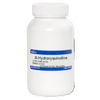8-Hydroxyquinoline is a quinolone compound and antifungal with chelating properties. It is a natural product found in the root exudate of the invasive plant Centaurea diffusa. When in aqueous solution, it reacts with metal ions, forming 8-hydroxyquinoline-chelate complexes. The complexes and the heterocycle itself have disinfectant properties. Its halogenated derivatives can be used as anti-infectives.
8-Hydroxyquinoline is freely soluble in ethanol, acetone, chloroform, and benzene but is insoluble in water.
| Application | Used as a chelating agent and quantitative determination of metal ions. Can be used as a carrier for radio-indium for diagnostic purposes. |
| Mechanism of Action | 8-Hydroxyquinoline is a RNA synthesis inhibitor that interferes with transcription. The antifungal activity appears to be structurally related but is not yet characterized. |
| Spectrum | Effective against fungi including Trichophyton mentagrophytes, Myrothecium verrucaria, and Trichoderma viride |
| Microbiology Applications | 8-Hydroxyquinoline can inhibit RNA synthesis in yeast cells by chelating essential divalent ions Mn2+ and Mg2+ required for RNA polymerase activity. |
| Plant Biology Applications | 8-Hydroxyquinoline is a floral preservative for cut flowers, increasing vase life by ~ 40% (Elgimabi and Ahmed, 2009) (Hojjati, 2007).
8-Hydroxyquinoline is a chelator of available iron and this property can be exploited by using the compound as a selective agent in low-iron media to screen for plant growth-stimulating and antagonistic fluorescent pseudomonads (Geels et al, 1985). |
| Eukaryotic Cell Culture Applications | 8-Hydroxyquinoline can be fluorinated to increase its activity as a metal ionophore and therefore is a promising diagnostic tool as a metal-binding agent capable of dissolving amyloid-beta (Aβ) deposits of zinc, copper and iron involved in the metal hypothesis of Alzheimer’s disease (Liang SH et al, 2015). |
| Solubility | Freely soluble in ethanol, acetone, chloroform, and benzene. Insoluble in water. |
| References |
Elgimabi MN and Ahmed OK (2009) Effects of bactericides and sucrose-pulsing on vase life of rose cut flowers (Rosa hybirida). Bot. Res. Intl. 2 (3):164-168 Fraser RS and Creanor J (2012) The mechanism of inhibition of ribonucleic acid synthesis by 8-Hydroxyquinoline and the antibiotic Lomofungin. Biochem. J. 147(3):401-410 Hojjati Y, Khalighi A and Farokhzad AR (2007) Chemical treatments of Eustoma cut flower cultivars for enhanced vase life. J. Agric. and Soc. Sci. 1813–2235 |



